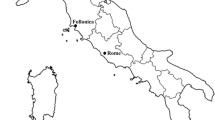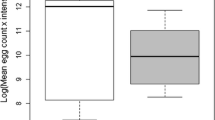Abstract
When colonizing a new area, introduced species may lose their original haemoparasites. If the local parasites are unable to infect the novel introduced hosts, these may gain a fitness advantage over their local competitors. Alternatively, the introduced species may be susceptible to local parasites and enter the local transmission dynamics. We studied these two possibilities in communities of wetland passerines infected with haemosporidians (genera Haemoproteus and Plasmodium) in Portugal, southwest Europe. Four introduced and six native (resident and breeding migrant) passerine species were tested for haemosporidians in four reed beds. Our results suggest that the introduced species have lost their original haemoparasites upon colonization and entered the local transmission cycle. Two local Plasmodium lineages infected the exotic species: one of them (SGS1) was the most host generalist and prevalent lineage in the native species, so was expected to be present in the exotics at random. The other lineage (PADOM01) was rarer in the sampled community, but was present in native hosts that are phylogenetically close to the infected exotic species; therefore, the colonization of the exotic host by PADOM01 seems to be constrained by the parasite’s specialization and by phylogenetic factors. When phylogeny was controlled for, there were no significant differences in infection prevalence and number of lineages between exotics and natives.
Zusammenfassung
Lokale Blutparasiten bei neu zugezogenen Sperlingsvögeln in Feuchtgebieten
Neu eingebürgerte Arten verlieren möglicherweise ihre originalen Blutparasiten, wenn sie ein neues Gebiet besiedeln. Sind die örtlichen Parasiten nicht in der Lage, die neu zugezogenen Wirte zu infizieren, gewinnen diese womöglich einen Fitness-Vorteil gegenüber ihren ortsansässigen Konkurrenten. Andererseits sind die neuen Arten vielleicht aber auch empfänglich für die örtlichen Parasiten und geraten dann in die örtliche Übertragungs-Dynamik. Wir untersuchten diese beiden Alternativen bei Gruppen von Feuchtgebiets-Sperlingsvögeln in Portugal, Südwest-Europa, die mit Haemosporidien (Haemoproteus und Plasmodium) infiziert waren. In vier Schilfgürteln wurden vier neu angesiedelte sowie sechs lokale (ortsansässige und brütende Zugvögel) Sperlingsvogelarten auf Haemosporidien getestet. Unsere Ergebnisse legen nahe, dass die neu zugezogenen Arten nach der Besiedelung ihre ursprünglichen Blutparasiten verloren und in die örtlichen Übertragungs-Zyklen gerieten. Zwei lokale Plasmodium-Verwandtschaftslinien infizierten die neu angesiedelten Arten: eine davon (SGS1) war der größere Wirts-Generalist und in den ortsansässigen Arten am weitesten verbreitet; wir erwarteten, dass er in den neu angesiedelten Arten zufällig verteilt war. Die andere Linie, PADOM01, trat in der Testgruppe seltener auf, war aber in denjenigen ortsansässigen Wirten vorhanden, die den angesiedelten, infizierten Arten phylogenetisch nahe standen. Demnach scheint die Kolonisierung der angesiedelten Wirtsvögel durch PADOM01 durch die Spezialisierung des Parasiten sowie durch phylogenetische Faktoren eingeschränkt zu sein. Ein Test der Phylogenie zeigte zwischen angesiedelten und ortsansässigen Tieren keine signifikanten Unterschiede in der Verbreitung der Infektionen und der Anzahl der Verwandtschaftslinien.
Similar content being viewed by others
References
Anderson RM, May RM (1978) Regulation and stability of host–parasite population interactions 1. Regulatory processes. J Anim Ecol 47(1):219–247
Arnaiz-Villena A, Ruiz-del-Valle V, Gomez-Prieto P, Reguera R, Carlos P-L, Serano-Vela I (2009) Estrildinae Finches (Aves, Passeriformes) from Africa, South Asia and Australia: a Molecular Phylogeographic Study. Open Ornithol J 2:29–36. doi:https://doi.org/10.2174/1874453200902010029
Beadell JS, Ishtiaq F, Covas R, Melo M, Warren BH, Atkinson CT, Bensch S, Graves GR, Jhala YV, Peirce MA, Rahmani AR, Fonseca DM, Fleischer RC (2006) Global phylogeographic limits of Hawaii’s avian malaria. Proc R Soc Lond B 273(1604):2935–2944. doi:https://doi.org/10.1098/rspb.2006.3671
Bensch S, Stjernman M, Hasselquist D, Ostman O, Hansson B, Westerdahl H, Pinheiro RT (2000) Host specificity in avian blood parasites: a study of Plasmodium and Haemoproteus mitochondrial DNA amplified from birds. Proc R Soc Lond B 267(1452):1583–1589. doi:https://doi.org/10.1098/rspb.2000.1181
Bensch S, Hellgren O, Pérez-Tris J (2009) MalAvi: a public database of malaria parasites and related haemosporidians in avian hosts based on mitochondrial cytochrome b lineages. Mol Ecol Resour 9(5):1353–1358. doi:https://doi.org/10.1111/j.1755-0998.2009.02692.x
Bonneaud C, Pérez-Tris J, Federici P, Chastel O, Sorci G (2006) Major histocompatibility alleles associated with local resistance to malaria in a passerine. Evolution 60(2):383–389. doi:https://doi.org/10.1554/05-409.1
Dimitrov D, Zehtindjiev P, Bensch S (2010) Genetic diversity of avian blood parasites in SE Europe: cytochrome b lineages of the genera Plasmodium and Haemoproteus (Haemosporida) from Bulgaria. Acta Parasitol 55(3):201–209. doi:https://doi.org/10.2478/s11686-010-0029-z
Duncan RP, Blackburn TM, Sol D (2003) The ecology of bird introductions. Annu Rev Ecol Evol Syst 34:71–98. doi:https://doi.org/10.1146/annurev.ecolsys.34.011802.132353
Durrant KL, Reed JL, Jones PJ, Dallimer M, Cheke RA, McWilliam AN, Fleischer RC (2007) Variation in haematozoan parasitism at local and landscape levels in the red-billed quelea Quelea quelea. J Avian Biol 38(6):662–671. doi:https://doi.org/10.1111/j.2007.0908-8857.04034.x
Garland T, Dickerman AW, Janis CM, Jones JA (1993) Phylogenetic analysis of covariance by computer-simulation. Syst Biol 42(3):265–292
Hall TA (1999) BioEdit: a user-friendly biological sequence alignment editor and analysis program for Windows 95/98/NT. Nucleic Acids Symp Ser 41:95–98
Hellgren O, Waldenstrom J, Pérez-Tris J, Szollosi E, Hasselquist D, Krizanauskiene A, Ottosson U, Bensch S (2007) Detecting shifts of transmission areas in avian blood parasites—a phylogenetic approach. Mol Ecol 16(6):1281–1290. doi:https://doi.org/10.1111/j.1365-294X.2007.03277.x
Hellgren O, Pérez-Tris J, Bensch S (2009) A jack-of-all-trades and still a master of some: prevalence and host range in avian malaria and related blood parasites. Ecology 90(10):2840–2849. doi:https://doi.org/10.1890/08-1059.1
Iezhova TA, Dodge M, Sehgal RNM, Smith TB, Valkiunas G (2011) New avian Haemoproteus species (Haemosporida: Haemoproteidae) from African birds, with a critique of the use of host taxonomic information in hemoproteid classification. J Parasitol 97(4):682–694. doi:https://doi.org/10.1645/ge-2709.1
Ishtiaq F, Gering E, Rappole JH, Rahmani AR, Jhala YV, Dove CJ, Milensky C, Olson SL, Peirce MA, Fleischer RC (2007) Prevalence and diversity of avian hematozoan parasites in Asia: a regional survey. J Wildl Dis 43(3):382–398
Johansson US, Fjeldsa J, Bowie RCK (2008) Phylogenetic relationships within Passerida (Aves: Passeriformes): a review and a new molecular phylogeny based on three nuclear intron markers. Mol Phylogenet Evol 48(3):858–876. doi:https://doi.org/10.1016/j.ympev.2008.05.029
Knowles SCL, Palinauskas V, Sheldon BC (2010) Chronic malaria infections increase family inequalities and reduce parental fitness: experimental evidence from a wild bird population. J Evol Biol 23(3):557–569. doi:https://doi.org/10.1111/j.1420-9101.2009.01920.x
Lima MR, Simpson L, Fecchio A, Kyaw CM (2010) Low prevalence of haemosporidian parasites in the introduced house sparrow (Passer domesticus) in Brazil. Acta Parasitol 55(4):297–303. doi:https://doi.org/10.2478/s11686-010-0055-x
Mack RN, Simberloff D, Lonsdale WM, Evans H, Clout M, Bazzaz FA (2000) Biotic invasions: causes, epidemiology, global consequences, and control. Ecol Appl 10(3):689–710
MacLeod CJ, Paterson AM, Tompkins DM, Duncan RP (2010) Parasites lost—do invaders miss the boat or drown on arrival? Ecol Lett 13(4):516–527. doi:https://doi.org/10.1111/j.1461-0248.2010.01446.x
Marzal A, de Lope F, Navarro C, Moller AP (2005) Malarial parasites decrease reproductive success: an experimental study in a passerine bird. Oecologia 142(4):541–545. doi:https://doi.org/10.1007/s00442-004-1757-2
Marzal A, Ricklefs RE, Valkiūnas G, Albayrak T, Arriero E, Bonneaud C, Czirják GA, Ewen J, Hellgren O, Hořáková D, Iezhova TA, Jensen H, Križanauskiene A, Lima MR, de Lope F, Magnussen E, Martin LB, Møller AP, Palinauskas V, Pap PL, Pérez-Tris J, Sehgal RNM, Soler M, Szöllosi E, Westerdahl H, Zetindjiev P, Bensch S (2011) Diversity, loss, and gain of malaria parasites in a globally invasive bird. PLoS ONE 6(7):e21905. doi:https://doi.org/10.1371/journal.pone.0021905
Matias R (2002) Aves Exóticas que Nidificam em Portugal Continental, 1st edn. ICN, Lisbon
Matias R, Catry P, Costa H, Elias G, Jara J, Moore CC, Tomé R (2007) Systematic list of the birds of Mainland Portugal. An Ornitol 5:74–132
Merino S, Seoane J, de la Puente J, Bermejo A (2000) Low prevalence of infection by haemoparasites in Cetti’s warblers Cettia cetti from central Spain. Ardeola 47(2):269–271
Norte AC, Araujo PM, Sampaio HL, Sousa JP, Ramos JA (2009) Haematozoa infections in a great tit Parus major population in Central Portugal: relationships with breeding effort and health. Ibis 151(4):677–688
Pérez-Tris J, Hellgren O, Krizanauskiene A, Waldenstrom J, Secondi J, Bonneaud C, Fjeldsa J, Hasselquist D, Bensch S (2007) Within-host speciation of malaria parasites. PloS One 2(2). doi:https://doi.org/10.1371/journal.pone.0000235
Round PD, Hansson B, Pearson DJ, Kennerley PR, Bensch S (2007) Lost and found: the enigmatic large-billed reed warbler Acrocephalus orinus rediscovered after 139 years. J Avian Biol 38(2):133–138. doi:https://doi.org/10.1111/j.2007.0908-8857.04064.x
Sambrook J, Russell DW (2001) Molecular cloning: a laboratory manual, 3rd edn. Cold Spring Harbor Laboratory, Cold Spring Harbor
Silva T, Reino LM, Borralho R (2002) A model for range expansion of an introduced species: the common waxbill Estrilda astrild in Portugal. Divers Distrib 8(6):319–326
Torchin ME, Lafferty KD, Kuris AM (2001) Release from parasites as natural enemies: Increased performance of a globally introduced marine crab. Biol Invasions 3(4):333–345. doi:https://doi.org/10.1023/a:1015855019360
Torchin ME, Lafferty KD, Dobson AP, McKenzie VJ, Kuris AM (2003) Introduced species and their missing parasites. Nature 421(6923):628–630. doi:https://doi.org/10.1038/nature01346
Treplin S, Siegert R, Bleidorn C, Thompson HS, Fotso R, Tiedemann R (2008) Molecular phylogeny of songbirds (Aves: Passeriformes) and the relative utility of common nuclear marker loci. Cladistics 24(3):328–349. doi:https://doi.org/10.1111/j.1096-0031.2007.00178.x
Valkiūnas G (2005) Avian malaria parasites and other haemosporidia, 1st edn. CRC, Boca Raton
Ventim R, Ramos JA, Osório H, Lopes RJ, Pérez-Tris J, Mendes L (2012) Avian malaria infections in western European mosquitoes. Parasitol Res. doi:https://doi.org/10.1007/s00436-012-2880-3
Vitousek PM, Mooney HA, Lubchenco J, Melillo JM (1997) Human domination of Earth’s ecosystems. Science 277(5325):494–499. doi:https://doi.org/10.1126/science.277.5325.494
Waldenström J, Bensch S, Kiboi S, Hasselquist D, Ottosson U (2002) Cross-species infection of blood parasites between resident and migratory songbirds in Africa. Mol Ecol 11(8):1545–1554. doi:https://doi.org/10.1046/j.1365-294X.2002.01523.x
Waldenström J, Bensch S, Hasselquist D, Ostman O (2004) A new nested polymerase chain reaction method very efficient in detecting Plasmodium and Haemoproteus infections from avian blood. J Parasitol 90(1):191–194. doi:https://doi.org/10.1645/GE-3221RN
Acknowledgments
This study was funded by the Fundação para a Ciência e Tecnologia (grant no. SFRH/BD/28930/2006 to R.V.) and by the Spanish Ministry of Science and Innovation (CGL2010-15734, to J.P-T.). The Instituto da Conservação da Natureza e Biodiversidade provided logistic support, permits for bird capture and help in the field work (by Vítor Encarnação, Paulo Encarnação, Nuno Grade and Paulo Tenreiro). The Pato Association also provided logistic support in Tornada. The authors would like to thank the help of Joana Morais in the lab and of several volunteers in the field work.
Author information
Authors and Affiliations
Corresponding author
Additional information
Communicated by F. Bairlein.
Rights and permissions
About this article
Cite this article
Ventim, R., Mendes, L., Ramos, J.A. et al. Local haemoparasites in introduced wetland passerines. J Ornithol 153, 1253–1259 (2012). https://doi.org/10.1007/s10336-012-0860-0
Received:
Revised:
Accepted:
Published:
Issue Date:
DOI: https://doi.org/10.1007/s10336-012-0860-0




